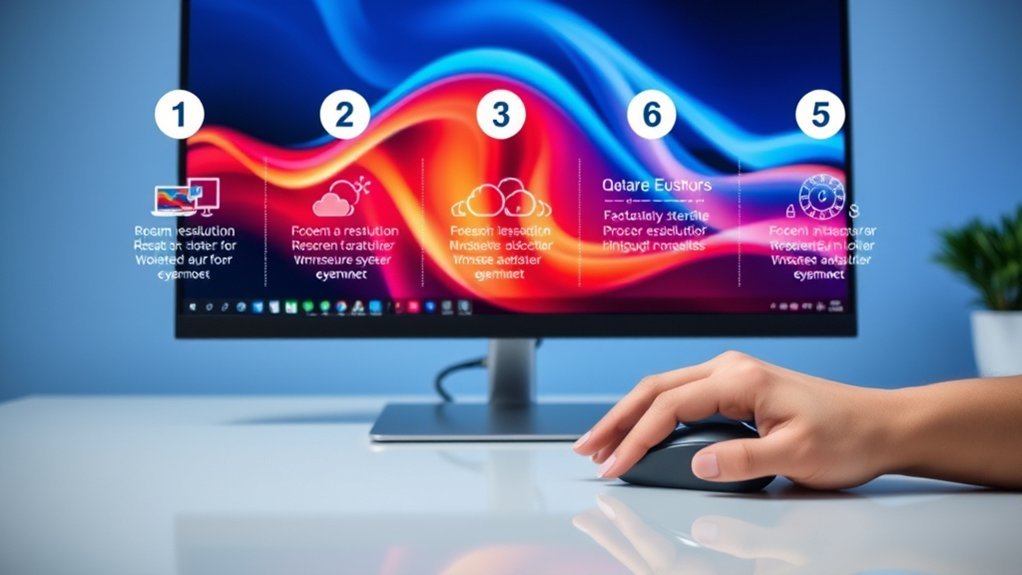Changing the screen resolution on Windows 11 is a straightforward process that can greatly enhance your viewing experience. By following just five guided steps, you can easily access display settings, select your monitor, choose the ideal resolution, and apply the changes. But what if you need to adjust scaling for an even better outcome? Let’s explore how to optimize your display settings effectively.
Accessing Display Settings
To change your screen resolution in Windows 11, start by accessing the Display Settings.
Right-click on the desktop and select “Display settings” from the context menu. Alternatively, you can press the Windows key and then type “Display settings” to find it quickly.
Once the Display Settings window opens, you’ll see various options related to your monitor’s configuration. This is your gateway to adjusting resolution, orientation, and scaling.
Make certain you’re in the correct section to liberate your view for better productivity and comfort.
Familiarizing yourself with these settings empowers you to tailor your visual experience, making your workspace more efficient and enjoyable.
Take control of your display preferences today!
Selecting the Display
When selecting the display in Windows 11, you’ll find options that allow you to choose which monitor you want to adjust, especially useful if you’re using multiple screens.
To access these options, right-click on the desktop and select “Display settings.” You’ll see a visual representation of your monitors labeled with numbers. Click on the monitor you wish to configure.
This enables you to identify each screen easily and select the one you want to modify without confusion. If needed, you can rearrange the displays by dragging them within the settings.
This feature empowers you to tailor your workspace to your needs, ensuring an ideal viewing experience across all your devices.
Choosing the Resolution
How can you achieve the best visual clarity on your screen? Start by choosing the right resolution for your display.
Windows 11 offers various resolution options, typically ranging from 800×600 to 3840×2160, depending on your monitor’s capabilities. Higher resolutions provide sharper images, while lower settings can enhance performance for less demanding tasks.
To find the ideal resolution, consider your screen size and usage. For general tasks, a resolution of 1920×1080 (Full HD) often strikes the right balance between clarity and performance. If you’re into gaming or design, you might opt for higher settings.
Experiment with different resolutions to see what works best for you, ensuring a liberated experience tailored to your visual needs.
Applying the Changes
Once you’ve chosen the right resolution for your display, applying the changes is straightforward.
Follow these steps to finalize your selection:
- Click “Keep Changes”: After selecting your desired resolution, a prompt will appear. Confirm your choice by clicking this option.
- Adjust Scaling Settings: If necessary, navigate to the scaling settings to guarantee text and icons appear correctly.
- Close the Settings Window: Once you’ve applied the changes, close the settings window to return to your desktop.
- Reboot (if needed): In some cases, a reboot might be required for the new resolution to take full effect.
Confirming the New Resolution
To confirm the new resolution, check if your display looks as expected after applying the changes.
Look for clarity in text, sharpness in images, and proper alignment of icons. If everything appears crisp and visually appealing, you’ve successfully set the new resolution.
However, if you notice any issues—like blurriness or misalignment—you can revert to the previous resolution by selecting “Revert” when prompted.
You’ll have a brief window to make this decision, so act quickly. If you’re satisfied with the new settings, click “Keep changes.”
This step guarantees your display operates at the best resolution for your needs, liberating you from visual discomfort and enhancing your overall experience on Windows 11.
Frequently Asked Questions
Can I Use Different Resolutions for Multiple Monitors?
Yes, you can use different resolutions for multiple monitors. Just go to your display settings, select each monitor, and adjust their resolutions independently. This way, you can optimize your workspace for each screen’s needs.
What if the Resolution I Want Isn’t Listed?
If the resolution you want isn’t listed, check your graphics driver’s settings. Updating drivers or using third-party software can release additional options, giving you more freedom to customize your display and enhance your experience.
How Do I Revert Changes if I Dislike the New Resolution?
To revert changes, right-click on the desktop, select “Display settings,” scroll down, and choose the previous resolution from the dropdown menu. Click “Apply,” and if you dislike it, you can revert within 15 seconds.
Will Changing Resolution Affect My Gaming Performance?
Yes, changing resolution can impact your gaming performance. Lowering it might boost frame rates, while increasing it can enhance visuals but strain your hardware. Find a balance that optimizes both performance and visual quality for your experience.
Is There a Shortcut to Access Display Settings Quickly?
Yes, you can quickly access display settings by pressing Windows + I to open Settings, then selecting System and Display. Alternatively, right-click the desktop and choose Display settings for instant access to your display configuration.
Conclusion
By following these five guided steps, you can easily change your screen resolution on Windows 11, transforming your display from blurry to crystal clear. Whether you’re gaming, working, or streaming, the right resolution enhances your experience. Don’t settle for less; a few clicks can make a world of difference. Embrace the clarity of your visuals, and remember that adjusting your screen settings can elevate both productivity and enjoyment. Now, go ahead and make those changes!

